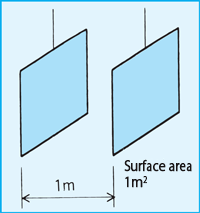About electric conductivity : Measuring electric conductivity
1. Measuring electric conductivity
Electrical conductivity is defined as "the inverse of the electrical resistance measured by filling a container in which two planar electrodes in the area 1㎡ are opposed at a distance 1m with an electrolyte solution." In other words, it shows the ease of electrical flow, and it can be said that it is the sum of the ions contained in a solution. Therefore, if it is meaningful to know the total amount of ions in the solution, or if the ion to be changed is known, it is a good densitometer for the target ion.
In addition, water quality meters are used mainly for pure water and boiler can water purity measurement, and are widely used for industrial/agriculturalral water, river, and lake water quality management.
2. Electric conductivity cell
Electrical conductivity cells are manufactured in various shapes according to the application by proportionally satisfying the relationship shown in the figure. The measuring range is from ultra-pure water of 5μS/m to 200S/m. The volume of the test solution is 1mL at a minimum, and there are immersion type and flow-through type.

3. Cell constant

Cell constants are the intrinsic values of the conductivity cell and should be calculated from the dimensions and shape. In reality, however, the structure of the conductivity cell is not simple, and it is very difficult to obtain them by calculation. In practice, this is determined by measuring the electrical conductivity of the standard solution of potassium chloride when it is measured. Ideally, the cell constant is "100m-1", but it varies within ±10% for manufacturing reasons. This is corrected by setting the cell constant of the main unit and setting the obtained value.
4.About conductivity display at 25℃
The electrical conductivity of a solution can vary with temperature.
Therefore, it is meaningless to simply indicate the electrical conductivity, and it is necessary to specify the temperature at that time. Also, when comparing, it is necessary to display at a certain unified temperature. The General Rules for Measuring JIS K 0130 Electrical Conductivity specifies that the standard temperature shall be 25°C.
